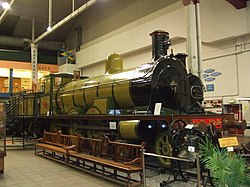Highland Railway

Map of the routes of the Highland Railway
|
|

Highland Railway "Jones Goods" (L.M.S. "4F") No.103 (L.M.S. No.17916), built by Sharp, Stewart in 1894
|
|
| Reporting mark | HR |
|---|---|
| Dates of operation | 1865–1923 |
| Predecessor |
Inverness and Aberdeen Junction Railway Inverness and Perth Junction Railway |
| Successor | London, Midland and Scottish Railway |
| Track gauge | 4 ft 8 1⁄2 in (1,435 mm) standard gauge |
| Length | 494 miles (795 km) |
| Headquarters | Inverness |
The Highland Railway (HR) was one of the smaller British railways before the Railways Act 1921, operating north of Perth railway station in Scotland and serving the farthest north of Britain. Based in Inverness, the company was formed by merger in 1865, absorbing over 249 miles (401 km) of line. It continued to expand, reaching Wick and Thurso in the north and Kyle of Lochalsh in the west, eventually serving the counties of Caithness, Sutherland, Ross & Cromarty, Inverness, Perth, Nairn, Moray and Banff. Southward it connected with the Caledonian Railway at Stanley Junction, north of Perth, and eastward with the Great North of Scotland Railway at Boat of Garten, Elgin, Keith and Portessie.
During the First World War the British Navy's base at Scapa Flow, in the Orkney Islands, was serviced from Scrabster Harbour near Thurso. The Highland Railway provided transport, including a daily Jellicoe Express passenger special, which ran between London and Thurso in about 22 hours. In 1923, the company passed on approximately 494 miles (795 km) of line as it became part of the London, Midland and Scottish Railway. Although its shorter branches have closed, former Highland Railway lines remain open from Inverness to Wick and Thurso, Kyle of Lochalsh, Keith (as part of the Aberdeen to Inverness Line), as well as the direct main line south to Perth.
The Great North of Scotland Railway (GNoSR) was formed in 1845 to build a railway between Inverness and Aberdeen and so link up with the railways to the south. The proposed 108 1⁄4-mile (174.2 km) route needed few major engineering works. At the same time, the Perth & Inverness Railway proposed a direct route over the Grampian Mountains to Perth, and the Aberdeen, Banff & Elgin Railway suggested a route that followed the coast to better serve the Banffshire and Morayshire fishing ports. The Aberdeen, Banff & Elgin failed to raise funds and the Perth & Inverness Railway was rejected by Parliament because the railway would be at altitudes that approached 1,500 feet (460 m) and needed steep gradients. The Great North of Scotland Railway Act received Royal Assent on 26 June 1846. Two years later the railway mania bubble had burst and the necessary finances could not be raised. Construction eventually began in November 1852, albeit only 39 miles (63 km) to Huntly, and this line was officially opened on 19 September 1854. An extension to Keith, halfway between Aberdeen and Inverness, opened on 11 October 1856.
...
Wikipedia
